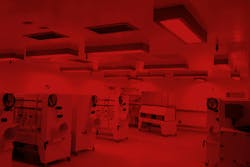The Case for Using Narrow Spectrum, Non-filtered Red LED Lighting in Animal Research Facilities
The right lighting is essential in animal research facilities to support the health and wellbeing of laboratory animals and the viability of the scientific research results attained. One specific area of interest is in protecting the circadian cycles of animals by controlling light exposure during experiments to best ensure accuracy in vivarium research projects. This means avoiding light-at-night (LAN) contamination during these natural dark cycles.
Understanding LAN Effects on Rodents
Because approximately 95% of U.S. biomedical research animals are rodents, researchers and vivarium designers have investigated how different wavelengths of light impact these nocturnal animals.
Findings show that the cones in rodents’ eyes lack sensitivity to longer wavelengths of light, anything above 620nm, which is seen as red light. This data has led to the general assumption that red light is either invisible to rodents or perceived as darkness.
Because certain nighttime light levels are required for the scientists observing experiments and for caretakers moving about in the rodents’ cages, the general practice has been to specify long-wavelength light for the animal holding rooms and adjacent corridors in these facilities.
“Eliminating all light exposure at night in vivaria is best for both animal welfare and experimental data, but when necessary, utilizing dim red light is an effective alternative to maintain circadian organization in laboratory species,” wrote authors Emmer et al. in the article, “Effects of Light at Night on Laboratory Animals and Research Outcomes” in Behavioral Neuroscience.
Some manufacturers produce troffers that provide red light by covering white LEDs with a red lens. However, these filters can degrade over time due to the plastic make-up of the lens and the heat from the fixture. The degrading filter will then cause the peak wavelength to shift over time, which may impact test data.
Fortunately, there are more advanced lighting solutions which more directly address this light sensitivity issue. Thanks to developments in LED technology, some manufacturers are offering a greater level of control over the spectral composition of their luminaires.
Narrow Spectrum LED
Some LED fixtures emit very precise, peak wavelengths of red light, as opposed to a more haphazard blend of the wavelengths within the broader spectrum of light. Called narrow spectrum lighting fixtures, architects can choose from a fixture that emits a peak wavelength of 630nm (red), 660nm (deep red) or 735nm (far red) technology.
With these fixtures, leaking white light is not an issue because white light is not produced by the light source.
Furthermore, newer research on lighting and rodents has made the availability of this narrow spectrum technology even more important.
In “Challenging a Myth and Misconception: Red-Light Vision in Rats,” published in the March 202 issue of Animals, the authors state, “mesopic red-light responses [from the rodents] were surprisingly high, emphasizing that even monochromatic light 656 +/- 10nm light is, contrary to the common assumption, very well perceived by rats.”
Consequently, the researchers conclude, “It is important to consider that when using red observation lights in dark settings, the light should be dim and of wavelengths as close to the infrared as possible. We advise to use monochromatic red LEDs with a peak emission of at least 660nm and to keep them as dim as possible.”
The researchers recommend lighting designers and architects specify red LED fixtures that produce narrow spectrum red light at either the 660nm or 735nm, which is even closer to infrared radiation.
When specifying light fixtures for vivaria, architects should look for a few other key features and performance ratings.
Dual-function fixtures, which can emit both red and/or white light, based on the time of day and need. For example, by producing light at 490nm during daytime hours, this can be of great benefit to the staff as this wavelength prevents melatonin production, which in turn promotes better sleep, health, and wellbeing, while still offering the narrow spectrum red light for evening hour observations.
The ability to power wash a lighting fixture in these areas is also important. The luminaire must be able to withstand the rigorous cleaning processes that takes place in these environments. In addition, the fixtures should be UL listed for wet locations and sealed to keep insects and pests out of the fixture housing.
Specifiers are also advised to look for fixtures that have seam-welded housings and are NSF-listed with closed-cell, extruded gaskets made from a nitrile material to best resist any vermin encounters.
Solutions with retrofit kits are particularly useful as the LED narrow spectrum red light fixtures can be installed without disrupting the laboratory’s water lines and electrical conduit in the ceilings.
In summary, when designing animal research facilities, select narrow-spectrum, non-filtered deep red (660nm) or far red (735nm) luminaires for observation areas as well as adjacent washrooms and hallways to prevent LAN contamination that may compromise the results of the research.
